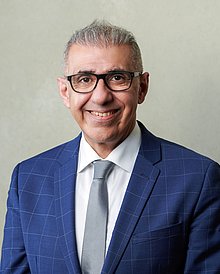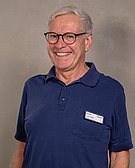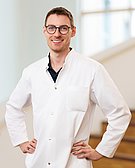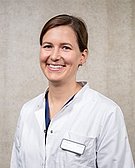School of Dentistry
Chair of Orthodontics
Prevention, therapy and innovative treatment concepts
Orthodontics is the specialised field of dentistry that covers the detection, treatment and prevention of misaligned teeth and jaw anomalies. The prevention of functional disorders and their treatment play a decisive role in this.
The interweaving of research projects with patient care, further training and teaching enables a modern and innovative therapy concept. The treatment spectrum ranges from orthodontic prevention to combined oral surgery and orthodontic therapy for adults, including patients with physical and mental disabilities.
The aim of the therapy is to achieve a balanced, functionally stable system by harmonising the position of the teeth and jaws as well as facial soft tissues. Orthodontic treatment can make an important contribution to maintaining the health of the masticatory system in the long term.
Chair

Prof. Dr.
Gholamreza Danesh
Chair holder
Faculty of Health (School of Dentistry, Oral and Maxillofacial Medicine) | Department of Orthodontics
Alfred-Herrhausen-Straße 44
58455 Witten
Room number: 2.193
Information for patients
An orthodontic consultation is possible at any time, even without a referral. To avoid waiting times, please make a fixed appointment.
All contact details can be found on the website of the University Clinic of Dentistry.
Interdisciplinary consultation hours:
- Speech therapy consultation: Wednesdays 9:30 to 11:30, by appointment
- Dysgnathia consultation: Wednesdays 9.30 to 11.30 a.m., by appointment
- Consultation hours for patients with craniofacial malformations: by appointment
- Consultation hours for patients with disabilities: Wednesdays 9:00 to 11:00, by appointment
Research
The Department of Orthodontics pursues several research specialisations, which we carry out together with cooperation partners within and outside the university.
Interdisciplinary collaboration takes place in clinical research, including with the specialisms of maxillofacial surgery, oral surgery, periodontology and speech therapy.
Research projects
- Studies on the validity of intraoral scans and alginate impressions
- Quantitative assessment of palatal bone thickness for the insertion of orthodontic implants using CBCT
- Investigation of the clinical reproducibility of virtual setups of the Insignia™ system in orthodontic-jaw surgery combination therapy - a prospective clinical study
- Effectiveness of treatment for positional plagiocephalus using customised head prostheses
- Incidence and severity of orthodontically induced external apical root resorption
- Investigation into the material properties of various orthodontic autopolymerising resins in comparison to light-curing resins
- In vitro investigation of direct luting of brackets - a comparative study of adhesives
- Long-term fluoride release from different material groups
- Orthodontic bonding systems
- Effects of palatal expansion on nasal breathing, soft tissue, tooth position, alveolar process and palate - a prospective comparison between the plastic cap splint and the modified Haas expander Palex (Palatal Expander)
- Modern methods for palatal expansion - prospective comparative study of the two skeletally anchored GNE appliances Maxillary Skeletal Expander and Hybridhyrax
- Study on the systematic correlation between the first milk tooth eruption and the eruption of the first permanent tooth

Publications
All publications of the Chair of Orthodonticsof the UW/H are summarised in the university bibliography.
Teaching
Orthodontic training should enable students to recognise and prevent dysgnathia, i.e. malformations of the teeth, jaw and masticatory system. The focus is on diagnosis and diagnostics. The basic principles of the forms of therapy based on this are worked out.
The teaching concept includes interdisciplinary co-operation with dentistry in theory and practice. In particular, we take periodontal aspects into account in pre-prosthetic and pre-surgical treatment measures. We also co-operate with general practitioners to solve complex orthodontic problems.
The focus of orthodontic training:
- Development and growth of the facial skull and teeth
- Etiology of malocclusions and jaw anomalies
- Orthodontic prophylaxis and preventive measures
- Interdisciplinary treatment concepts
- Early treatment
- Initial orthodontic consultation and assessment of findings
- Evaluation of diagnostic documents
- Basics of orthodontic treatment planning
- Legal guidelines for orthodontic treatment
- Basics of orthodontic therapy using removable and fixed treatment appliances
- Fabrication of removable orthodontic appliances
In the Orthodontics learning portal, students and training assistants can find orthodontic training and further education content (lectures, seminars, learning videos, scripts).
Further education and training
Modular Curriculum Orthodontics Part II (2025)
The Department of Orthodontics at Witten/Herdecke University is pleased to offer the pilot project 'Modular Postgraduate Curriculum' also in 2025. Thanks to our dedicated lecturers from practice and the university, we will continue to offer a structured curriculum as part of this pilot project, which supports sound further training in practice. In 2025, our programme is also aimed specifically at assistants in further orthodontic training. The modules will continue to be held in person and will remain free of charge with appropriate proof.
Further information can be found here:
Coordinator:
ZA Tim-Boyke Janssen
Registration:
Please register only via the following e-mail: Jasmin.Pastuszka@uni-wh.de, Tel.: +49 2302 / 926-645
Further training in orthodontics for dentists
The Department of Orthodontics at Witten/Herdecke University offers dentists the opportunity to complete further training in orthodontics after successfully completing their studies in dentistry.
According to the further training regulations of the Westphalia-Lippe Dental Association, the duration of further training is three years. At least one year of this must be spent in an authorised university clinic. A specialist orthodontic practice authorised for further training offers the opportunity to complete the remaining two years. It is necessary to complete the training programme continuously and full-time.
Please send applications for academic staff positions by e-mail only, preferably as a single PDF file, in the usual form and enclosing the following official documents:
- German school leaving certificate with qualification for higher education
- Examination certificate with individual proof
- Doctoral certificate (if available)
- Appointment/dental activity
- Proof of further training
Please send your documents to the following e-mail address: bewerbung.weiterbildung-kfo@uni-wh.de
Application documents received by post will not be processed and will be destroyed in accordance with the relevant legislation.
The team of the Chair of Orthodontics

Priv.-Doz. Dr.
Sachin Chhatwani
Senior physician
Faculty of Health (School of Dentistry, Oral and Maxillofacial Medicine) | Department of Orthodontics
Alfred-Herrhausen-Straße 44
58455 WittenRoom number: 1. OG

Dr.
Werner Schupp
Senior physician
Faculty of Health (School of Dentistry, Oral and Maxillofacial Medicine) | Department of Orthodontics
Alfred-Herrhausen-Straße 44
58455 Witten
Prof. Dr.
Dietmar Gesch
Lecturer
Faculty of Health (School of Dentistry, Oral and Maxillofacial Medicine) | Department of Orthodontics
Alfred-Herrhausen-Straße 44
58455 Witten
Dr.
Kai Hagemann
Lecturer
Faculty of Health (School of Dentistry, Oral and Maxillofacial Medicine) | Department of Orthodontics
Alfred-Herrhausen-Straße 50
58455 WittenRoom number: 1. OG

Dr.
Bassel Haddad
Lecturer
Faculty of Health (School of Dentistry, Oral and Maxillofacial Medicine) | Department of Orthodontics
Alfred-Herrhausen-Straße 44
58455 WittenRoom number: 1.OG

Dr.
Dominique Dimmek
Training assistant
Faculty of Health (School of Dentistry, Oral and Maxillofacial Medicine) | Department of Orthodontics
Alfred-Herrhausen-Straße 50
58455 WittenRoom number: E.97

Paul Grunau
Training assistant
Faculty of Health (School of Dentistry, Oral and Maxillofacial Medicine) | Chair of Orthodontics
Alfred-Herrhausen-Straße 50
58448 Witten
Dr med. dent.
Felix Linnerz
Training assistant
Faculty of Health (School of Dentistry, Oral and Maxillofacial Medicine) | Chair of Orthodontics
Alfred-Herrhausen-Straße 45
58455 Witten
Merle Küst
Training assistant
Faculty of Health (School of Dentistry, Oral and Maxillofacial Medicine) | Chair of Orthodontics
Alfred-Herrhausen-Straße 44
58455
Jannik Steur
Training assistant
Faculty of Health (School of Dentistry, Oral and Maxillofacial Medicine) | Chair of Orthodontics
Alfred-Herrhausen-Straße 44
58455 Witten